Chapter: 9th Science : World of Microbes
Microbes and their Types
Microbes and their Types
Microorganisms differ
from each other in size, morphology, habitat, metabolism and several other
features. Microbes may be unicellular (Bacteria), multicellular (Fungi),
acellular (not composed of cells-Virus). Types of microbes include bacteria,
viruses, fungi, microscopic algae and protists.
1. Bacteria
Bacteria are
microscopic, single celled prokaryotic organisms without nucleus and other cell
organelles. Although majority of bacterial species exist as single celled
forms, some appear to be filaments of loosely joined cells. The size varies
from less than 1 to 10 μm in length and 0.2 to 1 μm micrometer in width.
Bacteria may be motile or non-motile. For motility they have special structures
called flagella which are found on the cell surfaces. Location of flagella
varies with bacterial species.
Based on the arrangement
of flagella, there are four types of bacteria:
(i) Monotrichous: A single polar flagella. e.g. Pseudomonas
aeruginosa.
(ii) Lophotrichous: A cluster of polar flagella. e.g. Pseudomonas
fluorescens.
(iii) Amphitrichous: Either a single or cluster of flagella at
both the cell poles. e.g. Aquaspirillum serpens.
(iv) Peritrichous: Flagella arranged along
the sides of the bacteria. e.g. Salmonella typhi.
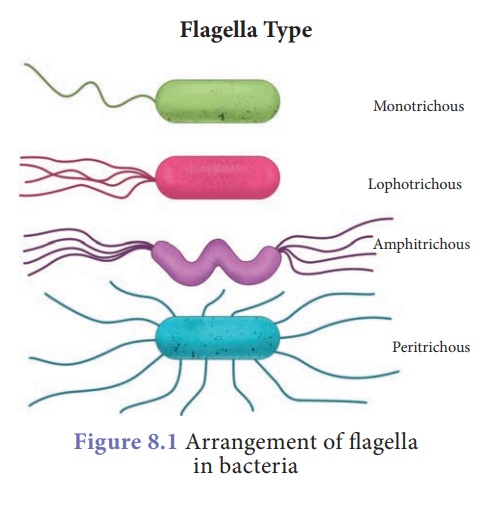
A. Shapes of bacteria
Based on the shapes,
bacteria are grouped as:
1. Spherical shaped
bacteria called as cocci (or coccus for a single cell).
2. Rod shaped bacteria
called as bacilli (or bacillus for a single cell).
3. Spiral shaped
bacteria called as spirilla (or spirillum for single cell)
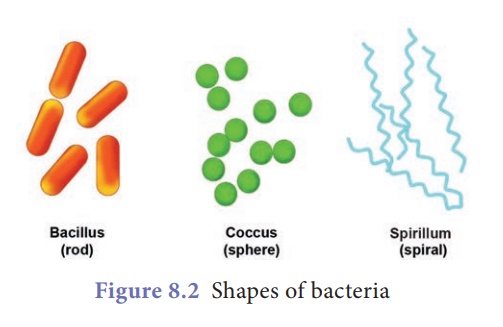
B. Structure of a bacterial cell
Bacterial cell has cell
membrane, covered by strong rigid cell wall made up of peptidoglycan. In
some bacteria, outside the cell wall there is an additional slimy protective
layer called capsule made up of polysaccharides. The plasma
membrane encloses the cytoplasm, incipient nucleus (nucleoid),
ribosomes and DNA which serve as genetic material. Ribosomes are the site of
protein synthesis. They lack membrane bound organelles. In addition to this, a
small extra chromosomal circular DNA called plasmid is found in the cytoplasm.
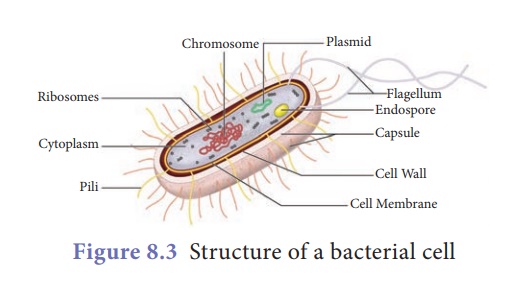
C. Nutrition in bacteria
All living organisms
require a source of energy. Bacteria have diversified energy requirements.
Based on this they are categorized into autotrophic bacteria and heterotrophic
bacteria.
a. Autotrophic bacteria (Autotrophs)
They synthesize their
own food from inorganic sources (CO2 and hydrogen donor). e.g. Nitrosomonas
sp. Autotrophic bacteria are classified into two types based on their
source of energy.
·
Phototrophs that use light as source of energy.
·
Chemotrophs that rely on chemical compounds for their energy.
b. Heterotrophic
bacteria (Heterotrophs) They are most abundant in nature. They do not synthesize
their own food but depend on other organisms or dead organic matter for food.
They may be classified as:
·
Parasitic bacteria that live on live hosts like plants,
animals and human. They can cause diseases to the living host.
·
Saprophytic bacteria that live on dead organic matter.
·
Symbiotic bacteria may live inside a live host, where they
obtain nutrition and benefit the host in digestion and nitrogen fixing (Rhizobium).
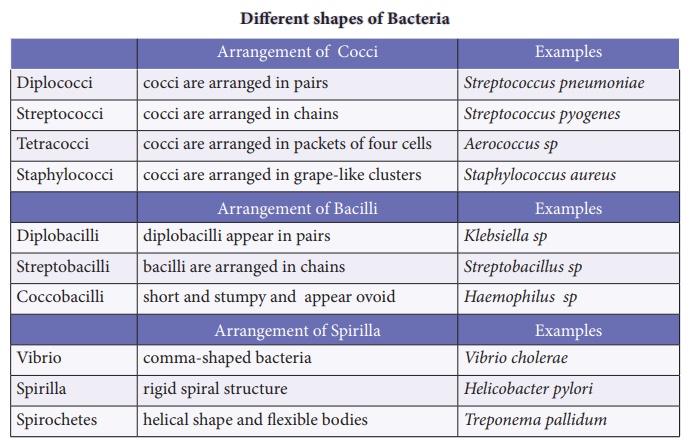
2. Viruses
The term ‘virus’ in
Latin means ‘venom’ or ‘poisonous fluid’. Viruses are non-cellular, self-replicating
parasites. They are made up of a protein that covers a
central nucleic acid molecule, either RNA or DNA. The amount of protein
varies from 60% to 95% and the rest is nucleic acid. Nucleic acid is either DNA
(T4 bacteriophage) or RNA (Tobacco mosaic virus, TMV).
A simple virus particle
is often called a virion. They grow and multiply only in living cells.
They are the smallest among the infective agents varying over a wide range from
18-400 nm (nanometre). They can live on plants, animals, human being and even
bacteria. They can be easily transmitted from one host to another.
A. Living and Non-living characters
Viruses exhibit both
living and non-living characters.
Living characters of viruses
·
They have the nucleic acid (DNA or RNA) i.e., the genetic material
that can replicate.
·
They can multiply in the living cells of the host.
·
They can attack specific hosts.
Non-living characters of viruses
·
Viruses remain as inert material outside their hosts.
·
They are devoid of cell membrane and cell wall. Viruses are devoid
of cellular organelles like ribosomes, mitochondria, etc.
·
They can be crystallised.
B. Types of Viruses
Viruses are categorised
as:
i. Plant virus: Virus that infect
plants. e.g. Tobacco mosaic virus, Cauliflower mosaic virus, Potato
virus.
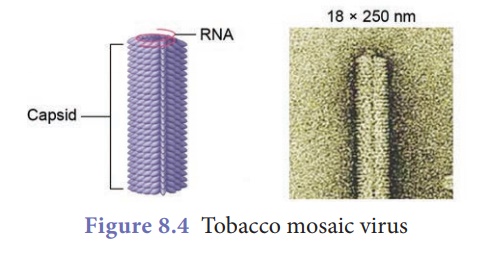
ii. Animal virus: Virus that infect
animals. e.g. Adenovirus, Retrovirus(HIV), Influenza virus, Polio virus.
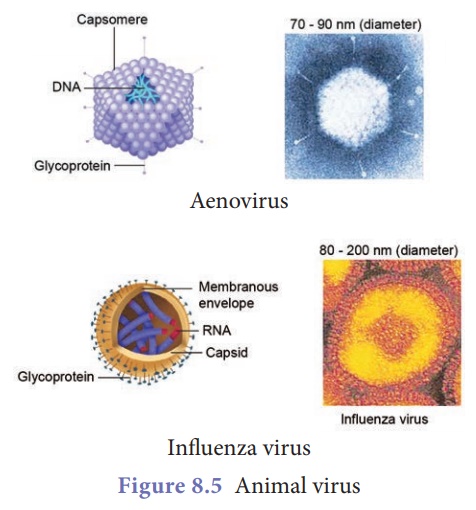
iii. Bacteriophages: Virus that infect
bacterial cells. e.g. T4 bacteriophage.
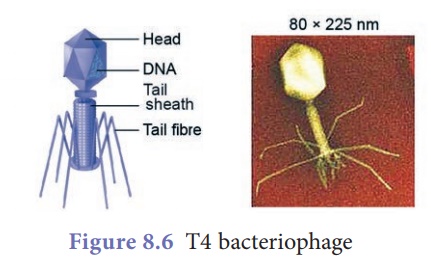
3. Fungi
They lack chlorophyll,
hence depend on living or dead host for their nutritional needs. Fungi living
on living hosts are called parasites, and those living on dead organic matter
are called saprophytes. The body of the fungus is called thallus.
In general, fungi are
larger than bacteria. Single celled yeast ranges from 1-5 μm in width. They are
spherical in shape. Flagella are absent and hence they are non-motile. In the
case of multicellular forms, thallus is called mycelium. Mycelium is a
complex of several thin filaments called hyphae (singular:
Hypha).
Each hypha is 5 to 10 μm
wide. They are tube like structures filled with protoplasm and cellular
organelles. Hyphae may or may not be intersected with plasmalemma (cell wall).
Cell wall is made up of cellulose and hemicellulose.
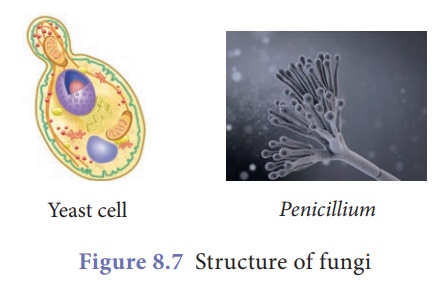
Cytoplasm contains small
vacuoles filled with cell sap, nucleus, mitochondria, golgi body, ribosomes,
and endoplasmic reticulum. Food material is stored in the form of glycogen or
oil globules.
They reproduce
vegetatively (binary fission, budding and fragmentation), asexually (spore
formation-conidia) and sexually (male and female gamatengium are called
antheridium and oogonium).
4. Prions
‘Prion’ means proteinaceous
infective particle (‘Protein gone bad’). The term 'prion' was coined
by Stanley B. Prusiner in 1982. Prions are viral particles which contain
only proteins. They do not contain nucleic acid. They are infectious and
smaller than viruses. Prions are found in neurons and are rod shaped. Prions
induce changes in normal folded proteins. Misfolded proteins aggregate and
accumulate as plaques. This results in the degeneration of nervous tissue.
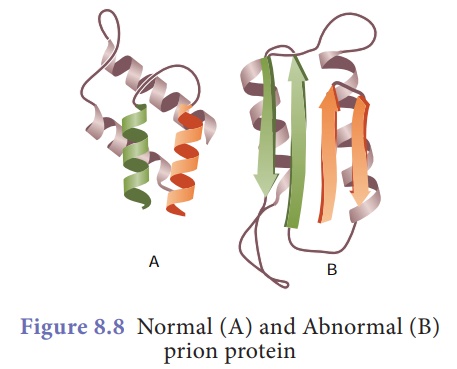
Related Topics